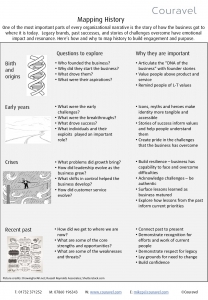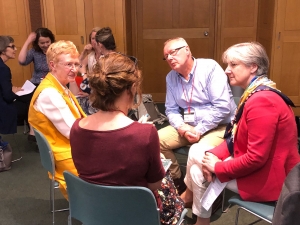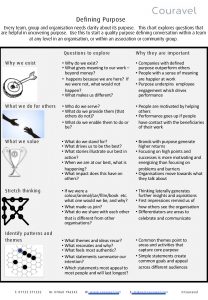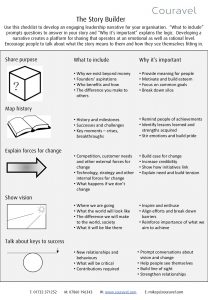Common challenges you’ve probably noticed
Digital development is demanding change in the way businesses are run and how they interact with their audiences and their employees. No matter what sector you’re in, you’re likely to be facing at least one of these challenges:
- Teams have less face-time as people share, work and interact more remotely.
- Employees and customers are enjoying new relationships with employers and brands as we move to self-serving models: this creates the need to rethink communication and engagement with employees and how we structure customer service roles.
- Employees want more opportunities to work with their employers to give back to society and the communities they serve.
- Organisations want more agile approaches with empowered employees who understand both company strategy and customer needs.
A solution starts with a conversation
Solving these issues requires processes that connect leaders, managers, project teams and front-line staff.
The traditional top down approach is hopelessly inadequate, especially in large organisations. A cascade approach is too slow when there are multiple levels of management and a complex organisational structure. “Top down” also contradicts the message that organisations need to empower their people to take more responsibility for the delivery of satisfaction and productivity.
Achieving that kind of collaboration across an organisation puts a premium on the need for quality conversations – conversations that help people work out how they can support strategic direction. The kind of conversation that encourages people to challenge, work out what they need to do to support change, and feel a high degree of ownership of the outcomes of the conversation.
Exploring the visualisation of strategy
Couravel has been using Big Pictures to help leaders define strategy and then to help teams engage with strategy. The power of visual representation of strategic and market issues is well proven. It was first written about in the Sears case study in the Harvard Business Review which introduced the Service-Profit Chain. At Sears, groups came to a better understanding of the marketplace and what they needed to do to support competitiveness by addressing questions posed by a visual representation of the High Street.
To explore its relevance today we asked 15 leaders from different businesses how developments in technology would affect their business in the next five years. Using ICA’s Technology of Participation (ToP) Consensus Workshop approach, they grouped their answers into seven main themes:
- Collaborative working
- Liberating structures
- Empowered customers
- Dynamic skill sets
- Disruptive markets
- New world of risks
- Big data.
Transformation challenges to address
We then invited them to draw these themes and use their insights and imagination to create a synthesis picture in real time.
The textual list below presents information related to transformational challenges, while the picture conveys the same information visually:
- Always on and changing working patterns – timing and geography no longer blockages
- Feedback is instant and we have to respond instantly
- Enable paradigm shift in service design and operation – focus on understanding and improvement
- Creating new skills to cope with technology change
- Using data to inform decisions
- Defining and mitigating new risks caused by over-reliance on technology
- Identifying and responding to new competitive challenges

What this gives the organisation is a visual representation of Digital Transformation and what it needs to do to navigate change.
To involve people in a conversation about how to respond to these challenges, the visual route represents an engaging starting point because it:
- Invites people to interpret what is going on
- Is easier to access (you do not need to understand jargon like “paradigm shift”)
- Provides information more quickly
- Leads to a less critical and more curious audience (lists invite a more critical, sceptical response).
Conversations around the visual
What is more important than the visual are the conversations around it; and they must be well facilitated. The visual becomes the focus for a conversation whereas questions draw people out.
For example, questions we used following the ORID framework of ICA’s ToP Focussed Conversation method include:
- What can you see in the picture? What else? (Objective)
- How do you feel about what you can see? Anything surprising, confusing? (Reflective)
- Where do you see yourself fitting? (Reflective)
- What could this picture mean for how we work with each other and our colleagues in other teams? (Interpretative)
- What risks do you think technology creates for us? (Interpretative)
- How might we be able to mitigate these risks? (Interpretative)
- How could we use new capabilities to provide better services for our customers? (Interpretative)
- What does that mean we need to do differently? (Decisional)
Using pictures to lead the conversation around Digital Transformation
This led to some penny-dropping moments for people involved in the leadership of change. For example:
- It is increasingly difficult to define and think in terms of “visions” as these rapidly become outdated in the face of global and disruptive competition.
- Consultants working with clients are experiencing their own journey of change through the digital landscape and the relationship between client and consultant needs to shift from the expert to the consultative model (i.e. where facilitators operate most effectively)
- This is also true of the relationship between customers and suppliers generally, but the changes are complex. In some respects, the relationship becomes more transactional and customers interface with technology to get what they want. This scenario sees people losing jobs as machines and robots take them over. But in other respects, the roles become more demanding and complex as the relationship becomes more akin to partnering: when customers want help it is because the technology cannot address more complex challenges (notice the bridge between suppliers and clients that is itself on wheels and constantly changing)
- The value of tangible, visual outcomes that can engage people more because they are visual, different and not prescriptive and that can convey some of the nuances and challenges of change (notice the trolls waiting to sabotage change work)
- The widespread application for approaches like this (see below).
Rethinking how we think about change
We need to rethink the process of change. If we want people to let go of past practices we have to pay more attention to the way individuals respond to change. To encourage people to collaborate to define new practices, here are a few “must haves”:
- Fun
- Novelty
- Laughter
- Celebration of past achievements
- Reflection time
- Generating our own ideas
- Feeling valued and connected
Using the Technology of Participation facilitation approach and visual thinking tools such as Big Pictures, we can create the kind of approach to collaboration needed to support transformation.
This approach is valuable in most change situations including:
- Introduction of new technology
- Mergers and acquisitions
- New strategy
- New strategy communication
- Brand evolution or launch/relaunch
- Design of new organisational processes
- Defining cultures, behaviours and values
Visuals and support provided by David Gifford.


 knowledge cafe1 (facilitated by David Gurteen at Portcullis House in Westminster) threw up some valuable insights and reflections.
knowledge cafe1 (facilitated by David Gurteen at Portcullis House in Westminster) threw up some valuable insights and reflections.



